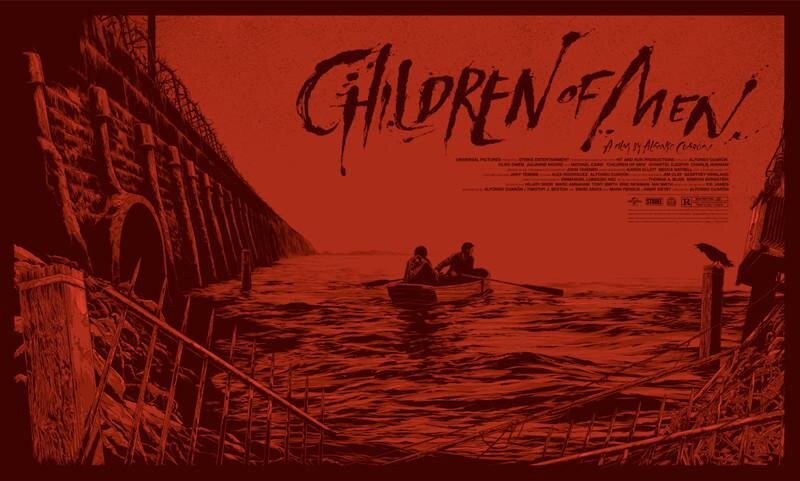
(Image: postersandtoys.com)
The Architecture of Hope and Desolation in Children of Men
By Jessica Ishizaka
Children of Men [1] poses a future where infertility threatens the human race with extinction. With the death of the youngest person in the world, many extreme groups have risen in order to gain control and take matters into their own hands. Laws are put in place to detain and deport immigrants and to control the citizens of London. The director of the film, Alfonso Cuarón, creates a political atmosphere that is particularly ruthless as he paints the world in a shade of dread and grime. The world and everything in it have been worn down and abused for 20 years, and no one has the ambition to replace or renovate anything since the extinction of the human race is near. The film takes place in a London which we do not recognize because of its state of disrepair. Its borders are congested with heavy, metal cages where illegal refugees are detained. As the plot develops, the main characters Theo and Kee, quickly transition from the urban environment to the still more savage countryside, until they reach Bexhill Internment Camp where they wait for rescue from the Human Project, an independent group of scientists who are dedicated to civilly curing infertility. Theo and Kee best tell this story through distinct accounts of hope and political resistance. Throughout this paper, I will discuss the significance of the spaces that Theo and Kee occupy and how architecture can generate hope and or desolation, especially in cinema.
In the film, Britain is locked in a totalitarian nightmare which results from a radical reaction as being the last functioning nation in the world. Although authority is a natural part of our society and culture, this authoritarian attitude can often look like an extreme solution to social problem. In Children of Men, the English Government has taken full control and has made immigration illegal. The immigrants who are fleeing terrible situations caused by war and poverty in their home countries, come to places that they hope will offer safety and security, only to be treated like a terrorist. Many of these refugees come to London in order to find work and better opportunities for themselves or for their families. In this case, these refugees are met with aversion and are taken to be deported or killed because many of the citizens of London are afraid of what the refugees from other ‘failed nations’ might bring to their city. The urban center in London is strikingly different from most of the other modern-day metropolitan cities that promote community, diversity and environmentally friendly habits. This version of London does quite the opposite, by increasing separation by race and income, contributing to environmental deterioration, and even the erosion of society’s-built heritage as one interrelated community. Part of this deconstructed urban center has to do with the idea of judicial other(ing) [2]. Judicial other(ing)refers to projecting negative attributes or characteristics on individuals or groups of people and treating this group as generally different than or inferior to the group you identify with. These foreign ‘terrorist subjects’ who are subjected to Bexhill are being used to create heightened and racialized ways of speculating and judging in the name of national security. It engineered a situation of widespread social panic and white paranoia where the public is kept on the edge and encouraging people to inform police of ‘suspicious’ behavior. All of these immigrants that are detained are solely based on that, conjecture and suspicious behavior. The government also projects hate and propaganda against individuals who are against the brutal and invasive fertility tests mandated by the government. The government of London is constantly surveying the land and the people who live there. Their surveillance tactics involve phone tapping, interception of emails, bugging and closed-circuit television networks. The government believes that it has a right to survey its citizens and act in the ‘best interest’ of London.
While Kee and Theo are running from the Fishes, a militant immigrants’ rights group, they are instructed to meet a correspondent at an abandoned school, that will take them into Bexhill. When Theo, Kee and the midwife Miriam enter the daunting school, hope is the furthest thing on their mind. The building itself is worn down and vandalized and the interior furniture and children’s toys are scattered across the room or broken. This scene instantly reminds the audience of the gravity of the world around them and exactly what is at stake if Theo cannot get Kee to safety. As Theo and Miriam are walking through the school, they happen to spot Kee sitting on a swing and in that moment, she becomes a powerful representation of hope for the future. Looking out of the broken glass, they see Kee, a young woman herself, thinking about the simple pleasure that she hopes to pass along to her own child. Hoping that she can bring a healthy baby into a safe and welcoming world. The warm sun is starting to set, and for a moment, everything is peaceful, almost back to normal before their correspondent comes to take them to Bexhill (see Fig. 3).
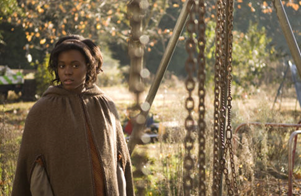
Figure 3
Bexhill, the refugee internment camp, is a fortress to keep criminals, refugees, and castaways separate from society. The entrance of Bexhill is met with the sign “Homeland Security. Bexhill Refugee Camp. Restricted Access” which arches overhead on a metal support. The brown building on the left shows a striking resemblance to the buildings at Auschwitz. This abandoned center was kept by the government to intimidate the detainees without a care about their physical or mental health and well-being.
In the film set, the outstanding resemblance to Auschwitz is not the only thing that gives Bexhill an eerie feeling. The set for Children of Men resembles certain characteristics of the silent horror film, The Cabinet of Dr. Caligari.[3] The Cabinet of Dr. Caligari utilizes expressionism to create a set that was sharp and skewed in order to make the audience uncomfortable and uneasy. Although the set is not animated like Dr. Caligari, many of the buildings in Children of Men are also jagged, decaying and skewed. In this setting, the city of London is not yet in ruins, but their aim was to make London more like Mexico City, amplifying the inequality and danger lurking just below the comfortable surface. This difference in the ambiance of London creates an eerie feeling of fear and anxiety that follows the citizens even after they leave the city. With bodies, blood and disease running into the streets of Bexhill, the emphasis on the physical decay of the city really articulates the social and cultural decay of the world, especially those held in Bexhill. The government has taken over and has disregarded the intentions of the people, for the sake of some ‘higher purpose’. As seen in Bexhill, disease, disintegration and deluge, all attributes of the physical environment, in this case also represent the current condition of society. As Carroll mentioned in her criticism of Krakauer’s disapproval of The Cabinet of Dr. Caligari, “the top-heavy facades heave forward, literalizing the idea that society is on the brink of toppling”[4]. With propaganda and prosecution covering the streets of London, the government is constantly cracking down on its citizens. Some citizens may see the fortification justified, since the youngest person in the world was just killed, who else would lead them and the rest of civilization into a secured future? Some of the angry citizens in Children of Men feel justified in catching and killing seemingly innocent bystanders, just as easily as Cesare was controlled and ‘hypnotized’ by his superior, Dr. Caligari. Both scenarios prove that absolute authority only drives irrational citizens further into mayhem, without an inkling of hope for their or others future.
Throughout the movie, the background is also important to emphasize the central themes of uprising and hope. It is important that the images that we see in the background, remain as the background. Having this tension between the foreground and background allows the viewer to not focus solely on these issues because the message will not be as impactful, but rather if these issues are brought up at an obscure angle in the background, it prompts the audience to really focus and understand these atrocities (see Fig. 2).[5]
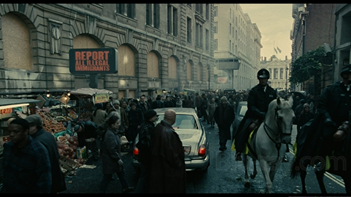
Figure 2
Seeing this version of London gives the audience an uncanny feeling. Referring to Sigmund Freuds definition of uncanny, it is the unsettling feeling one gets when they recognize that what they thought to be true, is not.[6] As previously mentioned, the city of London is not yet in ruins, but their aim was to make London more like the current situation that we are seeing all across the world, in: the Middle East, Hong Kong, Mexico City, Chile, etc.. The uncanny sensation in this sense is not how London is different than the current London, but how its situation is incredibly similar to other countries who are currently facing immigration problems and or civil wars. There are many places around the world where government surveillance and immigration control are reaching the point of this totalitarian image that Cuarón has constructed. There are people all over the world who live in an area’s similar to Bexhill and who face this reality every day. Many other countries from around the world are also facing similar issues, where they are not seeing growing fertility rates, but rather the opposite.[7]
Near the end of the film, Kee can no longer wait and seeks refuge in order to deliver her baby. Right before she is to give birth, Kee and Theo are taken into a decaying building by a feeble woman with a lantern. This scene bears similar features to the birth of Christ. Mary, Jesus’s mother, needed shelter to have her baby, but since there was no room at the inn, she gave birth in a manger (see Fig. 4).
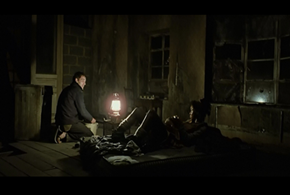
Figure 2
This similarity continues to strengthen the idea of new life and a new start being brought into the world. Kee finally manages to give birth on the floor of the run-down bank where the building’s structure is starting to bow, and walls are falling apart. Against all odds, Kee births a healthy baby boy. Still on the run from the Fishes, an organization that earlier tried to take Kee and her baby, Theo and Kee sought out protection in an abandoned apartment complex. This condemned apartment complex is currently under siege from the rebellion, the government, and now the Fishes. Hiding behind partial pieces of wall and large pieces of rubble, the baby begins to cry, revealing the newborn to those around them. As Theo and Kee try to escape and make their way down to the ground floor, refugees and soldiers alike stop to marvel at the miracle of this newborn baby. Refugees and soldiers are praying and adoring the baby as they pass by and all fighting between the two groups ceases until they are safely past (see Fig. 5).
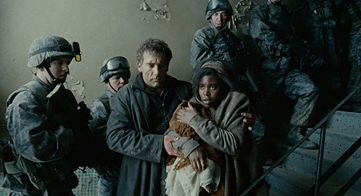
Figure 5
However, after Kee, Theo and the baby pass, the soldiers and the rebellious citizens continue to fight as if nothing had happened (see Fig. 1). This shattered society finally has a sign of hope amongst the rubble and debris left after years of war. Although this is the first baby to be born in 18 years it only takes one individual, this newborn baby, to act as an instrument that will move society forward and abolish all ideas or premonitions of giving up. This newborn represents new ideas, new culture, and a new beginning: a better and hopeful future.
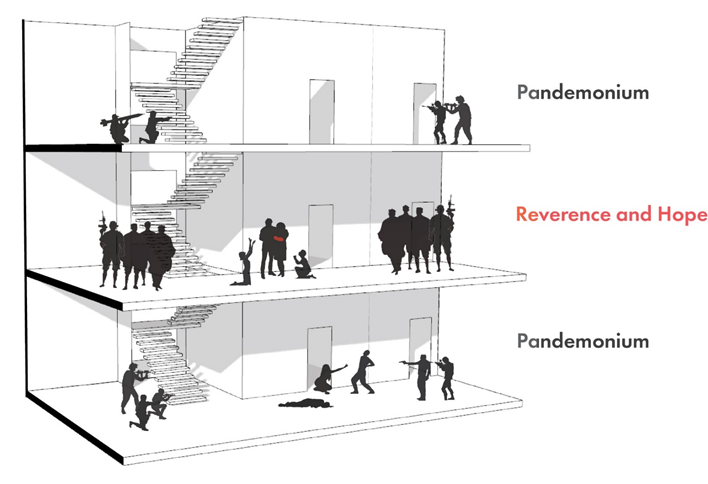
Figure 1
CITATIONS
[1] Children of Men. Universal Studios, 2006.
[2] Vahdat, Vahid. “Mediated Spaces.” Arch 530. October 14, 2019.
[3] Wiene, R. (Director). (1919). The Cabinet of Dr. Caligari [Video file]. Kino Lorber. Retrieved September 16, 2019, from Kanopy.
[4] Carroll, N. (1978). The Cabinet of Dr. Kracauer. Millennium Film Journal (ARCHIVE), 1(2), 77–85. Retrieved from http://search.proquest.com/docview/223253837/
[5] Arroyo, Anthony. “Zizek on Children of Men.” YouTube. YouTube, September 9, 2007. https://www.youtube.com/watch?v=pbgrwNP_gYE.
[6] Freud, Sigmund. "The Uncanny (1919)." Transl. by James Strachey. London: Hogarth (1971).
[7] Gallagher, James. “'Remarkable' Decline in Fertility Rates.” BBC News. BBC, November 9, 2018. https://www.bbc.com/news/health-46118103.

LOGO DESIGNED BY MEENTS ILLUSTRATED
from REVIEW BLOG - Every Movie Has a Lesson https://ift.tt/2P0h35V







No comments:
Post a Comment